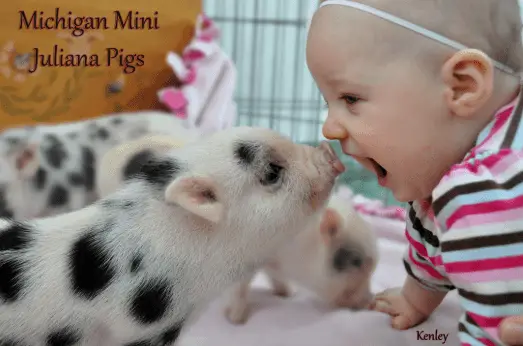Pigs are not as common as any other house pet which is why many of us have little to no idea on how they naturally behave. We also know pigs for their bad image, but pigs are actually amazing and can be very affectionate.
So how do pigs show affection? Pigs can show their affection through nudging, snout kissing, lap visiting, cuddling and sometimes they can also lick to express their fondness towards you.
Pigs communicate through body language and vocal communication but we can solely rely on their body language most of the time.
Showing affection can be different for every pig too, as they each can develop their own unique personalities apart from their breed’s standard temperament.
How can we tell if they are showing affection?
At first, for new owners, it can be confusing and that is why it is important to pay attention to a pig’s body language and vocal tone when they around us.
Body language speaks more volume that their vocal communication since they can be quiet depending on their personality.

In order to understand what your pig is trying to tell you, we should familiarize ourselves with their behavior and common ways of communication which is their body language.
What are the signs of affectionate behavior in pigs
You may not know that your pig is already being affectionate with you, so below will be the list of common affectionate behavior from pigs.
- Tail wagging — indicates happiness, contentment, excitement
- Tailing — following around also means they are interested in you, asking for your attention or simply just wants to stay near you out of love
- Nudging — when a pig keeps “pushing” you with their snouts, it means they are curious about you, asking for your attention or simply means they want to show you they love you!
- Lap visiting — some pigs rarely like to be clingy, but when they enjoy sitting on your lip and sometimes even begging for it, it probably means they love being around you.
- Snout kissing — is similar to nudging, but with more affection. Snout kissing is when you can feel the desire to “lick you” or “kiss you” using their snouts.
- Accepts cuddles — pigs are prey animals and do not enjoy physical contact but when they do, it probably means they trust you and love you.
- Licking — licking may be rare to happen but if they do, it can be perceived as affectionate behavior similar to kissing.
- Zooming — when they happily run around with happy faces, it can be perceived as a sign of happiness and excitement. They must be happy to see you or spend time with you.
- Smiling — pigs can smile and the meaning behind it is pretty obvious!
- Playing — if they are being playful around you, it can also be a sign of affection. Some pigs can be shy and won’t let their playfulness show with other people.
How pigs show affection through body language and vocal communication
Once again, we rely solely on a pig’s body language to determine what they are trying to tell us and make us understand.
Most animals have a really short range of options to express themselves but pigs can find ways to go beyond their limitations.
Some owners can really find it surprising how a pig behaves!
The reason behind this is because pigs are incredibly intelligent creatures. Pigs ranked fifth among the most intelligent animals in the world, can outsmart dogs and chimpanzees and are said to have the same intelligence level as a 2 year old child.
Being pretty clever, pigs can think of methods to communicate better through body language. Certain body language could mean different things.
Apart from affectionate behavior, they can also show confusing behavior that we may not understand at first-hand.
What are the other noticeable behavior in pigs
Digging — can be a sign of hunger, boredom, playfulness or it can mean your pig can smell food or hear something that captures their interest in the specific area they are digging at
Being stubborn — is a sign of protest or showing you their grudge, can also be a sign of showing dominance and an attempt to establish a manipulative behavior
At times it can also be a sign of being spoiled, or a way to humor owners if pigs are conditioned to think stubbornness is “cute” or “adorable”
Biting — is a sign of aggression, dominant behavior but can also be due to fear and shock. Biting should not be tolerated and must be corrected.
Read our article about how to discipline a pig.
Charging — might be a sign of fear, aggression, dominant behavior but can also be a hint of desire to play
Rolling — is a sign of feeling filthy, they may want to tell you they want to cool off or bathe, it can also possibly mean they are being playful and want to show it by rolling around.
Sometimes it means they might want to play outside, or in mud
Hiding — is a clear way of showing you they are afraid, they are prey animals and can easily be terrified. Depending on the situation, it can also be a sign of playfulness.
Crying — pigs can cry real tears when they are mourning, but they do not cry out of joy. When a pig cries, it should be important to comfort them.
Playing with food — some pigs play with their food to let you know they didn’t like it or they don’t want too much of it, sometimes it’s just a part of their mischievous personality.
How pigs interact with you through vocal communication
There is not much we can tell from a pig’s vocal tone, but there are a few clear signs that can help us understand them better. There are different kinds of “grunts” which can also be called “oinks” depending on your pig.
- Calm grunts — might be trying to get your attention
- Continuous grunts — needs something, trying to warn, may be annoyed, bored or feeling lonely
- Low, sad toned grunts — can be a sign of crying, grieving, mourning, loneliness, or in pain
- Loud grunts — may be trying to warn, can be a sign of excitement, trying to show dominance, expressing anger or displeasure
- Crying grunt — sign of depression, sickness, loneliness, sadness, pain
What are the uncommon Behavior of pigs
There are times when pigs may exhibit behavior that is not seen among other pigs and can raise curiosity and serious concern for some. Here are some uncommon behaviors that you need to look out for.
- Continuous crying
If you have no idea why your pig won’t stop crying and there is no reason for them to be depressed, sad, grieving or such, there might be an underlying problem that we are not aware of.
Pigs cannot speak our language but they can behave the same way as a baby that cries because it is the easiest way to tell us something they can’t.
Non-stop crying can be a sign of hidden illness or pain for pigs that our naked eyes cannot see.
If you suspect unusual behavior in your pig, consult your veterinarian.
- Threatening violence
Naturally, pigs are gentle and
peaceful animals but if they exhibit aggressiveness, it can be dangerous
especially if they are large and have tusks that can be deadly.
A pig that cannot be disciplined or continues to show alarming and disturbing
behavior could be a victim of mistreatment, abuse or trauma and needs deeper
understanding in order to find out how to fix them.
If you suspect your pig is starting to become threatening, consult an expert.
- Wall licking or self-harming
If there is nothing to lick on the wall and yet your pig continues to do so, it might be a sign of sickness.
When a pig harms themselves, it can be a clear sign of depression and must be treated as soon as possible.
Pigs are capable of doing the following self-harm methods
— banging their heads against concrete
— refusing to eat and refuses force feeding
— jumping off high areas
— intentionally getting themselves sick
— intentionally putting themselves in danger
Pigs are smart animals and they can do a lot of things that may surprise us. They have many ways to express and communicate which is why we must also be careful and understanding towards them.
Related Questions
- How to bond with your pig?
There are many ways to bond with your pig but it should follow the common process and requires patience and understanding.
First, you must gain their trust. To gain their trust, you have to be patient and let them become familiar with you, your place and everything around them.
Once they are familiar with you and their environment, they will be at ease and may willingly express themselves immediately. To form a bond, always interact with your pig and socialize with them.
Even if animals can’t talk, a pig is smart and can possibly comprehend what you are telling them. You can start playing with them, doing small activities and even teaching them to do certain tricks.
There are also certain activities that your pig can enjoy with can help strengthen your bonds. You may read “How to Bond with Your Pig?” to learn more.
- What do pigs like?
Pigs like a wide variety of things. They are not picky and high maintenance which means pigs like many types of fruits and vegetables, they enjoy certain chips and treats and specific fun activities to do.
Most pigs like cool climate, rooting or digging, water over mud, outdoor lifestyle, playing with other pigs, exploring and socializing.
They can also develop their own personal preferences because pigs are smart animals and their intelligence contributes to how their unique personalities develop.
It is important to become familiar with your pig to find out their unique habits, preferences and dislikes.
Finding out what a pig likes can happen naturally and there are a lot of things and choices to choose from. Learning about a pig only requires patience and genuine love.
